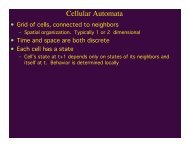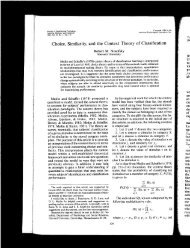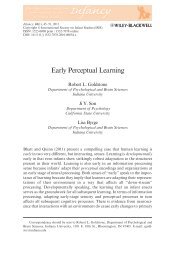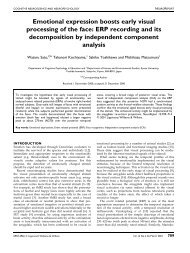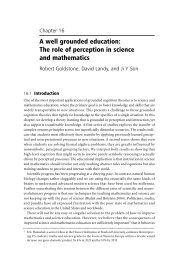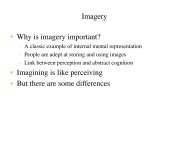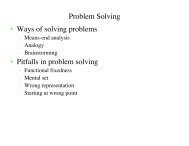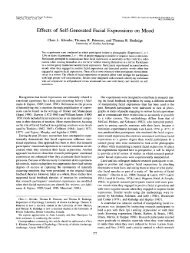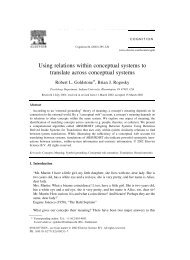the psychology of learning and motivation - Percepts and Concepts ...
the psychology of learning and motivation - Percepts and Concepts ...
the psychology of learning and motivation - Percepts and Concepts ...
You also want an ePaper? Increase the reach of your titles
YUMPU automatically turns print PDFs into web optimized ePapers that Google loves.
The Ubiquitous Patterns <strong>of</strong> Incorrect Answers to Science Questions 257have <strong>the</strong> same slope. Therefore, this is consistent with <strong>the</strong> hypo<strong>the</strong>sis thatstudents answer according to <strong>the</strong> features <strong>of</strong> <strong>the</strong> question that capture <strong>the</strong>most attention. In <strong>the</strong> case <strong>of</strong> <strong>the</strong> crossed lines, <strong>the</strong> irrelevant dimension <strong>of</strong><strong>the</strong> values <strong>of</strong> <strong>the</strong> lines captured attention <strong>and</strong> led many students to <strong>the</strong>incorrect response.One advantage <strong>of</strong> <strong>the</strong> hypo<strong>the</strong>sis that bottom-up attentional allocationcan play a role in incorrect answering patterns is that it can potentially bemeasured <strong>and</strong> tested independent <strong>of</strong> student response choices. For example,one can operationally define overt eye gaze (as measured by an eyetracker) as a measure <strong>of</strong> attention (cf. Rehder & H<strong>of</strong>fman, 2005).Specifically, <strong>the</strong> dimension that results in <strong>the</strong> first <strong>and</strong> longest fixationsis considered as <strong>the</strong> one capturing <strong>the</strong> most attention (<strong>and</strong> is <strong>the</strong> mostsalient). In <strong>the</strong> example in Figure 6, one would expect, for example, thatattention would be fixed on <strong>the</strong> intersection <strong>of</strong> <strong>the</strong> lines on <strong>the</strong> secondgraph.Note that <strong>the</strong> term salience is used in many contexts, <strong>and</strong> it is importantto use <strong>the</strong> term consistently. Informally speaking, <strong>the</strong> salience <strong>of</strong> a cue ordimension is usually defined as <strong>the</strong> quality <strong>of</strong> st<strong>and</strong>ing out or being morenoticeable compared to o<strong>the</strong>r cooccurring dimensions. Salience is <strong>of</strong>tenmore formally regarded empirically as a quality <strong>of</strong> a cue or dimension that,separate from relative predictiveness, affects attention to (e.g., Kim &Cave, 1999; Lamy, Tsal, & Egeth, 2003) <strong>and</strong> <strong>the</strong> <strong>learning</strong> <strong>of</strong> (e.g.,Edgell et al., 1992; Hall et al., 1977; Kruschke & Johansen, 1999;Trabasso & Bower, 1968) a cue relative to o<strong>the</strong>r present cues.Therefore, one may operationally define salience in a number <strong>of</strong> ways.For example, one may define <strong>the</strong> salient dimension as <strong>the</strong> one that attracts<strong>the</strong> most attention, as measured by eye tracking.It is also important to keep in mind that <strong>the</strong> attention to a cue ordimension depends on <strong>the</strong> context. For example, <strong>the</strong> relative attention totwo given cues can depend on <strong>the</strong> presence or absence <strong>of</strong> o<strong>the</strong>r cues; thus,changing <strong>the</strong> perceptual or conceptual format <strong>of</strong> <strong>the</strong> context may change<strong>the</strong> relative attention to two cues. Fur<strong>the</strong>rmore, attention (or salience)depends on bottom-up mechanisms operating at <strong>the</strong> level <strong>of</strong> perceptualfeatures as well as on top-down mechanisms operating at <strong>the</strong> level <strong>of</strong>cognitive strategies, for example, controlling a search task (e.g., Egeth& Yantis, 1997). Therefore, our measures <strong>of</strong> relative attention to specificdimensions should be regarded as specific to particular questions <strong>and</strong> tasks.None<strong>the</strong>less, <strong>the</strong> mechanism <strong>of</strong> attention to salient dimensions <strong>and</strong> itspossible effect on student answering is general.In a number <strong>of</strong> recent studies on enhancing multimedia <strong>learning</strong>, eyetracking results have shown that participants are distracted by irrelevantfeatures <strong>and</strong> tend to look at more relevant areas <strong>of</strong> diagrams after instruction(Canham & Hegarty, 2010) <strong>and</strong> at relevant areas <strong>of</strong> animations if <strong>the</strong>yare highlighted (Boucheix & Lowe, 2010), or if <strong>the</strong>y are experts (Jarodzka,




